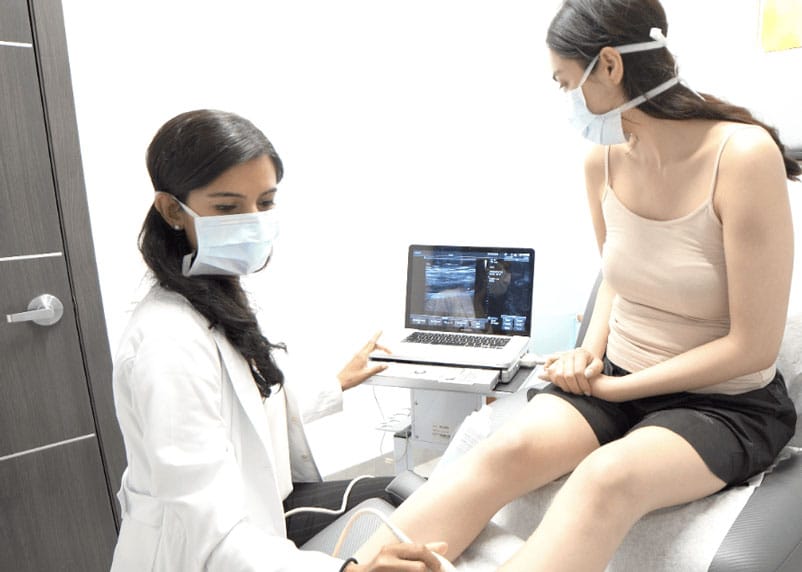If you have been experiencing heaviness in your legs, especially at the end of a long day spent on your feet, you may be dealing with a vein disease. Spider veins and varicose veins bulging on your lower limbs, as well as painful and weary legs, are telltale symptoms that you have vein disease. Because your blood tends to make its way down to your legs and build pressure, vein disease causes heaviness or exhaustion, especially at the end of the day.
Think back to how your legs looked and felt five or 10 years ago. If your legs are noticeably more weary or achy at the end of the day than they used to be, you should consult a vein doctor at a vein treatment clinic about treatment options. Many individuals believe that these signs and symptoms are just part of growing older, but venous insufficiency and spider veins can, and should, be treated at a vein clinic!

Making a decision about where to seek treatment for heaviness in your legs can seem complicated, so a great way to start is by evaluating the treatment options the vein center offers. At Vein Treatment Center New York, you can be sure to expect state-of-the-art treatment from excellent doctors. Click HERE to book an appointment at our excellent vein clinic, or keep reading to learn more about the best options for treatment.
There are some at-home remedies that you can use to temporarily alleviate the heaviness in your legs, but the only permanent way to cure this ailment is by seeking medical care. Here are three easy ways to take some pressure off your legs until you can get to a vein center:
Keeping Legs Elevated
Spider veins and varicose veins occur when blood reverses direction and pools around the veins in the legs instead of traveling to the heart. Elevating your legs and using gravity to aid blood flow back to your heart is an excellent technique to prevent this, because it improves blood circulation, reduces leg swelling, and prevents blood from accumulating in your veins. Some examples are by propping your feet up under your desk at work or resting your feet on a few pillows.
Massage
Not that anyone needs an excuse to get a massage, but in addition to the fact that they are relaxing and stress-relieving, massages also improve blood circulation. Gentle pressure can help relieve pain and discomfort from varicose veins, as well as improve blood flow by stimulating surrounding muscle tissue. Be careful to avoid applying direct pressure to the varicose veins, because varicose veins are tender to the touch, and direct pressure can injure the thin and fragile skin in that area.
Exercise
Regular exercise has a slew of advantages, and one of the most important for persons with spider veins and varicose veins is that aerobic movement helps improve blood circulation in the legs and force collected blood back into normal flow patterns. Even thirty minutes of low-impact activities that raise your heart rate and train your calf muscles every day will increase blood circulation dramatically. Swimming, walking, hiking, jogging, or cycling are some examples of workout, and be sure to stretch afterward to get the most out of them.
Although surgery used to be the only way to treat varicose veins and spider veins, vein doctors can now use minimally invasive therapies that only require a small incision rather than a large surgical opening to seal off the damaged veins and reroute blood flow. These procedures are associated with lower risks, shorter procedural time, and less recovery time after your visit to the vein clinic. To guarantee that you are receiving the finest level of care, find a vein doctor at a vein clinic that offers minimally invasive procedures.
1. Sclerotherapy and Varithena
During a sclerotherapy procedure, a vein doctor uses tiny needles to inject a medicine, called a sclerosant, into damaged veins.This medicine irritates the vein linings, causing them to clump together and close up the vein, which reroutes blood to healthier veins. Due to a lack of blood flow, the sections of the vein injected with medicine will shrink over time, minimizing the appearance of spider veins. Varithena is a sclerotherapy foam injected by a vein doctor into the vein to reduce both the appearance and symptoms of large, bulky varicose veins.
2. Radiofrequency Ablation
Radiofrequency ablation starts with a local anesthetic, then the vein specialist uses ultrasound imaging to guide a small catheter to the damaged vein, where it is activated and delivers thermal energy to the vein walls to close them down. This procedure, which redirects blood flow to healthy veins to improve circulation, has a 97% success rate and is effective immediately.
3. VenaSeal
VenaSeal is a vein adhesive used to seal the saphenous vein in the leg that is a common root cause for varicose veins. The VenaSeal glue closes the diseased vein within seconds, and this seal will eventually reroute the blood automatically through the healthy veins in your legs, decreasing the appearance of bulging varicose veins.
Our Vein Treatment Clinic location in New York City is conveniently located in the heart of New York (the Big Apple!), near notable landmarks such as Madison Square Park. You can schedule your consultation with any of our three incredible vein doctors and be assured of the best possible care.